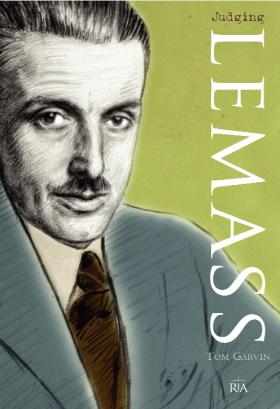Judging Lemass: the measure of the man
Published in 20th-century / Contemporary History, Book Reviews, Issue 1 (Jan/Feb 2010), Reviews, Volume 18Tom Garvin
(Royal Irish Academy, E30)
ISBN 9781904890577
 Tom Garvin opens his introduction to this book with the truthful statement that ‘Seán Lemass is commonly seen as the architect of modern Ireland’. Regrettably, he does not acknowledge that, in current circumstances, this could earn the said architect some censure as a jerrybuilder. What Garvin does do is give a reasonably accurate general picture of his subject. Lemass was ‘very much a city boy all his life’ (pp 38–9); ‘a classic national radical; no socialist’ (p. 260); he ‘learnt very early the virtues of patriotism, along with hard work, skilled labour and systematic supervision of a work force’ (p. 38); he had ‘great respect for capitalist entrepreneurship . . . possibly exaggerated’ (p. 178).
Tom Garvin opens his introduction to this book with the truthful statement that ‘Seán Lemass is commonly seen as the architect of modern Ireland’. Regrettably, he does not acknowledge that, in current circumstances, this could earn the said architect some censure as a jerrybuilder. What Garvin does do is give a reasonably accurate general picture of his subject. Lemass was ‘very much a city boy all his life’ (pp 38–9); ‘a classic national radical; no socialist’ (p. 260); he ‘learnt very early the virtues of patriotism, along with hard work, skilled labour and systematic supervision of a work force’ (p. 38); he had ‘great respect for capitalist entrepreneurship . . . possibly exaggerated’ (p. 178).
The weakness appears when the man is measured against his context. Garvin does not investigate a number of significant aspects of his subject’s career. On the other hand, he begins with a chatty account of Lemass’ ultimately pointless visit to Belfast in 1965 and gives space to rehashing the Treatyite arguments of his book 1922, though in a more balanced manner than there (after all, Lemass opposed the Treaty). This imbalance mars the author’s analysis of Lemass as organiser of the 26-county economy after 1932. He makes much of his subject’s previous vague aspirations towards European free trade while making little of Lemass’ criticisms of his Cumann na nGael opponents’ policies, though these would have prevailed had inter-war Europe been united.
The context was that the failure to complete the Irish revolution had left a skewed economic system in the southern state, not only because of partition (though that did not help) but because the parties ruling the new state represented bourgeois groups with opposing economic perspectives. On one side were those around Cosgrave’s Cumann na nGael, the ranchers and others with vested interests in the British market. Against these were the small business classes, supporting Lemass’ Fianna Fáil, seeking protection that they might grow big. Neither perspective was adequate. In long-term economics Lemass’ colleague Gerald Boland (with Joe Connolly) made more sense, proposing ‘industry based on fish, food and farming’ (pp 134–5). That would have involved a far greater attack on rural vested interests, however, and a greater expansion of education against clerical resistance, conceivable only through a revolutionary alliance with the urban working class, to which Boland and his allies were hostile. Though wasteful, Lemass’ strategy was the only way to minimise unemployment within society as it was.
Even within those bounds his record should be questioned. In 1924, the most specific promise of the manifesto (quoted and illustrated, pp 79 and 112) of his first successful election campaign was free education, ‘including free books and luncheon . . . and a proper system of scholarships . . . enabling the child of the poorest Irishman to reach the University’. This has not been achieved yet. Indeed, Lemass served in successive governments with an education record as regressive as that of any in the state’s history. Did he protest in cabinet? Was there a deliberate demarcation of interests between himself and de Valera? Certainly greater blame lies with the latter. Nonetheless, Donogh O’Malley had to present Lemass with a fait accompli to get free secondary schooling. Lemass may have rationalised this by his reliance on economic forces to solve all problems; here they were not wholly successful.
His responsibility was more obvious in respect of transport. He neglected the railway system. Fianna Fáil fought the 1933 and 1944 elections on its refusal to nationalise; it would be the inter-party government that did so. Whether this was because Lemass’ faith in new technology caused him to see the internal combustion engine as rendering the train obsolete or whether, like Todd Andrews, he disliked the railways as products and bastions of the old ascendancy is unclear. Nonetheless, his policies contributed to a transport problem that is only starting to be tackled.
Other unanswered queries are more personal. It may be pointless to speculate on the long-term effect of Noel Lemass’ murder on his younger brother’s career, and whether Noel rather than Seán would have become the minister. Perhaps more fruitful is the question of how Seán, a religious sceptic who spoke and voted against the introduction of literary censorship (unmentioned here), ended up in the Knights of Columbanus. Was it solidarity with them in his fear of divorce and contraception (p. 256)? Finally, why did one who prided himself on taking risks nominate to succeed him Jack Lynch, whom he must have recognised would prefer to avoid making mistakes by avoiding bold initiatives?
The book is very well illustrated, though more care should have been taken with the captions. The poster accredited to Cumann na nGael’s 1933 election campaign (p. 118) was obviously used in the election of 1932. It should be said, too, that it would not have required much research to identify the figure seated on the far right of the photograph of de Valera’s 1932 Executive Council (p. 145) not, as given, as ‘unknown’ but as James Geoghegan, minister for justice. HI
D. R. O’Connor Lysaght is a writer and historian.
















